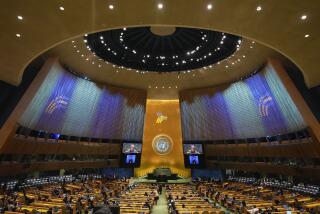SPECIAL REPORT: Seeking a New World : Notes on the Current Status
- Share via
OF POPULATION
There are currently an estimated 5.3 billion people on the planet, with the number expected to grow at an annual rate of about 1.5% throughout the 1990s, according to the World Bank. That means the world population will top 6 billion near the end of the decade. Even though the growth rate is expected to slow down after that, another billion will probably be added before the year 2010. The fastest population growth is in those countries least capable economically of sustaining it. By 2025, the percentage of humanity living in less-developed nations will rise from 1985’s 75.7% to 84.1%.
OF QUALITY LIVING
The Population Crisis Committee, a Washington-based think tank, recently rated the quality of life in the world’s 100 largest metropolitan areas. Based on such indicators as infant mortality, air quality, traffic flow, public safety, education, communications, food costs and living space, the group rated Melbourne, Australia, Montreal, and Seattle as the world’s most livable urban environments. At the bottom of the list: Lagos, Nigeria; Kinshasa, Zaire; Kanpur, India; Dhaka, Bangladesh; and Recife, Brazil. Los Angeles was ranked 16th, with a “good” quality of life.
OF HUMAN RIGHTS
Despite dramatic reforms in the Soviet Union, Eastern Europe and South Africa, thousands of people were arrested, tortured and killed last year by governments trying to suppress ethnic and nationalist tensions, Amnesty International said in its 1990 report. The London-based human rights group said that in countries like Ethiopia, Myanmar (formerly Burma), Somalia and Sudan, long-standing ethnic tensions have erupted in sweeping attacks on peasants in opposition areas or killings based solely on ethnic origin.
OF THE ENVIRONMENT
Among global environmental problems, depletion of the ozone layer, deforestation and global warming appear to be at the top of the political agenda at the moment. Brazil is to host a U.N. Conference on Environment and Development in 1992, with the aim of building on two existing agreements: the 1979 Convention on Long-Range Transboundary Air Pollution and the 1985 Convention on Protection of the Ozone Layer. The goal of the 1992 conference is to stabilize carbon dioxide emissions, promote energy efficiency and reduce the pace of deforestation.
OF ECONOMICS
With its goal of establishing a single European market by the end of 1992, the European Community will become an economic powerhouse second--barely--only to the United States. Its 12 member countries have a collective gross national product of $4.8 trillion. They are: Belgium, Britain, Denmark, France, Germany, Greece, Ireland, Italy, Luxembourg, Netherlands, Portugal and Spain.
OF NUCLEAR ARMS
There are five acknowledged nuclear weapons states: The United States, Britain, Soviet Union, France and China. In addition, India has also detonated a nuclear device. Israel is believed to have manufactured nuclear weapons. Top officials in both South Africa and Pakistan have stated publicly that their countries have “the capability” to make nuclear weapons should they desire to do so. Iraq’s nuclear capabilities have been debated. In 1981, Israel stalled Iraq’s nuclear program when it bombed a nuclear reactor under construction outside Baghdad.
OF TRAVEL
This year, the U.S. State Department issued warnings or advisories urging caution or restricting travel to 52 countries. They include: Bangladesh, Bolivia, Burma, Chad, Chile, China, Colombia, Cyprus, Ecuador, El Salvador, Gabon, Ghana, Guatemala, Haiti, Honduras, India, Iraq, Israel, Jordan, Kenya, Liberia, Mauritania, Mozambique, Nepal, Nicaragua, Northern Ireland, Pakistan, Peru, Philippines, Rwanda, Senegal, Somalia, South Africa, Soviet Union, Sri Lanka, Sudan, Suriname, Trinidad and Tobago, Vietnam, Yemen, Yugoslavia, Zaire, Zambia, Zimbabwe.
OF FOREIGN AID
According to the U.S. Agency for International Development, the primary recipients of U.S. foreign aid in 1989 were Israel, $1.2 billion; Sub-Saharan Africa, $1.053 billion; Egypt, $968 million; Philippines, $389 million; Pakistan, $352 million; El Salvador, $308 million; Bangladesh, $180 million; Guatemala, $147 million; Costa Rica, $122 million; Jamaica, $115 million; Morocco, $93 million.
OF LITERACY
Recent statistics issued by the U.N. Educational, Scientific and Cultural Organization showed that 25% of the world’s population over the age of 15 is illiterate. It is believed that as many as 1 billion people in the world cannot read or write. In the 42 countries listed by the United Nations as the least developed in the world, most people are illiterate. Illiteracy is also a problem in developed nations. Surveys indicate that between 10% and 20% of the people in various industrial nations are illiterate.
More to Read
Sign up for Essential California
The most important California stories and recommendations in your inbox every morning.
You may occasionally receive promotional content from the Los Angeles Times.













